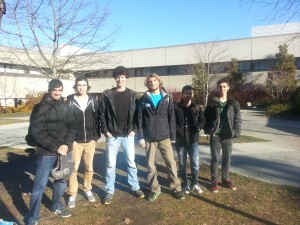This blog post will deal with how we implemented our plan for the project, including installation, organization, safety aspects, mistakes and changes in procedure.
In our original plan, day one would involve cutting the bamboo poles into 4 foot sections, and this would be completed by Riley, Shane and Nolan. Team members were expected to bring safety equipment (such as goggles) with them to the site as the client was unable to provide them.
Upon arrival to the site, it was realized that none of the team members actually had goggles, and there was a short wait while Nolan and Riley went to buy some. Soon after they had returned, marking and cutting of the bamboo began. Gloves were provided by the client, as was a generator, 2 battery-powered drills, a gas powered hole digger, a chop-saw and shovels. We were required to obtain our own first-aid kit, and brought a drill to be powered by the generator as well as two hand-saws and a hockey stick (to knock out sections of bamboo).
Due to weather conditions, a light rain which became heavy downpour later in the day, the generator was unsafe to use and as such neither was the electrically powered chop-saw. This meant that once every pole had been marked for cutting, it would have had to be done using the two-hand saws we brought to the site. The need for the hand-saws was an unexpected event, and caused a longer timeframe for cutting than expected. Nonetheless, we were able to have every pole cut by the end of the day with time to spare, meeting plan objectives.
Once the poles had been cut, we began to knock out sections from the bamboo, which proved to be much more difficult than originally expected. Our original plan had this portion taking only an hour, but due to the limitations of the equipment we used (only had one hockey stick) and misguided assumption that the sections would not be very sturdy meant that we spent roughly 2 hours to complete less than half of the bamboo poles. After a short time we decided to try out the post-hole digger and found it to be very effective. Shortly after this, Riley noticed a sign informing us not to dig lower than 1 foot due to electrical wires near the site. We gave the client a call, and though she was not aware of the wires she was unconcerned about them and wished us to continue digging. Instead we decided to continue knocking out sections and Riley contacted Susan Nesbit to gain her advice. At this time, the rain began to pour more strongly, worked slowed, and when our mentor arrived to survey our work we decided to end and continue on the next day.
For day 2 we had a number of objectives we wished to see completed, namely knocking out the remaining sections and drilling holes in bamboo, holes in the ground, planting and filling of the poles. With only a day left, everyone in the team showed up early (except Nolan) to help. Upon arrival, it was decided that due to time constraints we would not be able to complete the entire project, and instead we would attempt to get prototypes in the ground for the client’s volunteers to continue once we could not. This meant that no more sections would be knocked out; instead we focused on drilling and planting the fence.
With some team members working on drilling, it turned out that the drills provided by the client were very low on battery power. When we attempted to start the generator, the cord broke and we were left with very little power to work with, further restricting the amount of work we would be able to finish. Team members drilled holes in the bamboo until the power ran out, and using the gas powered digger we dug a number of holes and planted our prototypes. Confident that the volunteers would see our prototypes and be able to continue our work, we called it a day and forwarded instructions to the client.
In the end, we managed to complete a functional fence on a small portion of the site, with instructions to enable others to finish the project in the future. We completed some objectives, such as cutting the bamboo and planting some poles, but had limited success on others (knocking out sections, drilling holes in poles) and were unable to complete some entirely (planting herbs). As we managed to complete some of the fence, we consider our project to be a moderate success.









